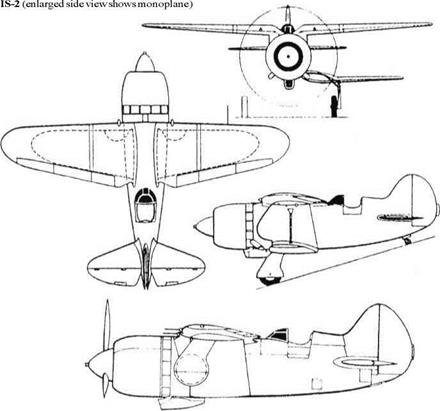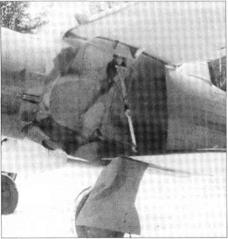Nikitiii Shevcheiiko IS-2
Purpose: Improved version of IS-1 Design Bureau: OKB-30, chief designer V V Shevchenko
The initial funding allocated to Shevchenko’s project actually paid for two prototypes. Though construction of both began in parallel it was soon decided to incorporate improvements in the dubler (second aircraft). Designated IS-2, and also known as the I-220t>/s, this emerged from GAZ No 156 in early 1941. Surviving documents differ. One account states that the IS-2 ‘was ready in January 1941…the War broke out and only four test flights were carried out.’ Three other accounts, in Russian, French and English, state that the aircraft was completed in April 1941 but had not flown when the Germans invaded. Shavrov is non-committal, but notes that all performance figures are estimates. The
walk-round outdoor photos were all taken with snow on the ground.
The IS-2 was a refined derivative of the IS-1. The engine was an M-88 14-cylinder radial rated at l,100hp, neatly installed in a long – chord cowl with a prominent oil-cooler duct underneath and driving a VISh-23 propeller with a large spinner, but retaining Hucks starter dogs. According to Podol’nyi, the fuselage cross-section was reduced (which is certainly correct) and, while wing spans remained the same, chord was reduced in order to increase aspect ratio and reduce area. Shavrov and a French author state that the wings of the IS-1 and IS-2 were geometrically identical. What certainly was altered was that the landing-gear retraction system was replaced by simply connecting the main legs to the wing linkage, so that a single cockpit lever and a single pneumatic jack folded
the lower wings and the main landing gears in a single movement. It is widely believed that the IS-2 was not intended to fly in combat as a biplane, the benefits being restricted to take-off and landing. In the IS-1 documentation the idea that the aircraft might be operated as a biplane is never mentioned. Ifit were, then what was the point of the folding lower wing? Further modifications in the IS-2 were that the tail was redesigned, the tailwheel could retract and the two inboard ShKAS were replaced by heavy 12.7mm Beresin BS guns.
By the time this aircraft appeared, even though it looked more modern than its predecessor, the WS was fast re-equipping with simple monoplane fighters. These unquestionably stood more chance against the Luftwaffe than the IS-2 would have done.
|
Span (upper) |
8.6 m |
28ft rnn |
|
(lower, extended) |
6.72 m |
22 ft tf in |
|
Length |
7.36 m |
24 ft P/i in |
|
Wing area (as biplane) |
20.83 m2 |
224ft2 |
|
(upper only) |
13.0m2 |
140 ft2 |
|
Weights |
||
|
Loaded, Shavrov’s ‘estimated |
2,180 kg’ |
|
|
is probably a misprint for |
2,810kg |
6,195 Ib |
|
Performance (estimated) Shavrov’s speed of588 km/h and ceiling of 1,100 m are suspect, and Podol’nyi’s ‘600 km/h’ is even less credible; the only plausible figure appears to be the 507 km/h (315 mph) of the French account. |

|
|
|
|
|
|













